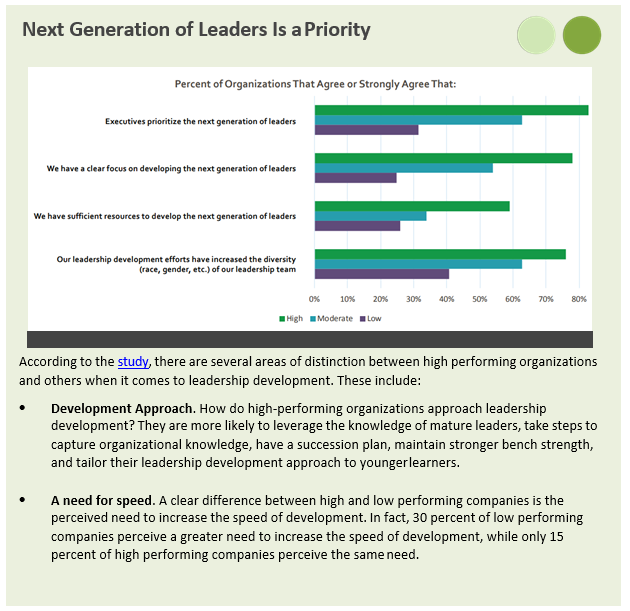Why Leaders Must Begin Developing Leaders
Executive and leadership development has risen to the top of most companies’ priority list over the past decade, with the realization that in the fast-changing, innovation-led business landscape organizations must have exceptional leaders to navigate it. In fact, studies by McKinsey & Company and J.P. Donion have found a close correlation between the skills of a company’s leaders and market performance. However, research by Deloitte and the U.S. Federal Reserve show that return on assets (ROA) and productivity growth – both key measures of leadership success – have shown a steady decline since the 1960s.
This exposes a real challenge facing organizations today – implementing effective leadership development to build stronger capabilities. This issue is particularly urgent given the youngest of the Baby Boomer leaders will turn 61 this year, raising the importance of replacing the departure of these older leaders. As a result, organizations are realizing that if they don’t start to prepare next generation leaders for future roles now, they will face an uphill battle filling them in the future. In short, top executives will need to aggressively find ways for leaders to develop leaders.
Higher Performing Organization Focus on Next Generation Leaders
A second-annual survey conducted by Training magazine and Wilson Learning Worldwide finds there is a strong desire and great need to strengthen leadership development efforts. In particular, efforts aimed at meeting the needs and expectations of the next generation of leaders. Furthermore, the study discovered high-performing organizations make developing the next generation of leaders a priority. As Graph 1 shows, these companies are significantly more likely to indicate that executives prioritize the development of younger leaders, the organization has a clear focus on the next generation and sufficient resources are directed toward their development.

According to the study, there are several areas of distinction between high performing organizations and others when it comes to leadership development. These include:
- Development Approach. How do high-performing organizations approach leadership development? They are more likely to leverage the knowledge of mature leaders, take steps to capture organizational knowledge, have a succession plan, maintain stronger bench strength, and tailor their leadership development approach to younger learners.
- A need for speed. A clear difference between high and low performing companies is the perceived need to increase the speed of development. In fact, 30 percent of low performing companies perceive a greater need to increase the speed of development, while only 15 percent of high performing companies perceive the same need.
- Leadership transition. One of the largest areas of difference between high- and low-performing organizations is the degree to which organizations support new leaders in the transition to a leadership position. In fact, high-performing organizations are much more likely to help new managers through the transition by helping them manage priorities, develop relationships, overlap with the existing manager and advance their leadership skills.
Is Your Organization’s Top Leadership Doing Enough?
Leadership development must start at the top. Key questions you should be asking yourself include, “What are we doing to prepare our next generation of leaders? Is our leadership pipeline sufficient to carry our company in the future? Who is leading the development of our new leaders? How are our key leaders involved?”
In order for top leaders to become experts at developing leaders, they must have leadership development at the top of their action list and know exactly what those actions need to include. In short, they need to know what to do and why. Here are 5 critical factors to ensuring successful leadership development:
1. Know the Criteria that’s Key to Leadership Success
Successful companies ensure their leadership development efforts are strategically-driven and see business strategies as inseparable from leadership development. Senior leaders need to examine the emerging issues and challenges facing their company, and consider the unique skills required to resolve them.
An important step to investing in the future of your organization is discovering the competencies, skills and gaps of your existing employees, and benchmarking those against the critical skills needed for executive positions in your industry and for your culture. Look to utilize validated executive assessments to provide objective, science- backed data to drive your development efforts. Through assessments you can identify the people who are best prepared for leadership as well as those in need of further development.
Once identified, individuals with growth promise can benefit from accelerated development plans to help bridge the gap between current strengths and growth areas. The specific strategies and areas of focus must align with the business objectives and needs of the organization, the future role requirements, and the individual’s own goals.
2. Leadership Development is not a One-off Event
Successful organizations see leadership development as a strategy as opposed to a project. While many companies treat the issue as a short-term fix, building a long-standing, structured process begins with developing the company’s leaders from early in their employment. Leaders must place as much rigor into the leadership development effort as they do in sales, marketing or other areas in the organization.
Senior leaders need to understand and accept that leadership development is a lengthy process. Consider creating and adopting a leadership development philosophy that defines the principles the organization espouses and provides direction for those crafting the plan. This can also serve as an effective communication tool to help the organization understand leadership development.
3. Leaders Should Develop Leaders
Senior leaders need to accept the important role they have in developing future leaders by owning and sponsoring development efforts. In fact, leaders of successful organizations spend as much as one-third of their time in developing others.
Development planning driven by objective, validated assessment data provides companies a very clear path to developing leadership talent. In order to keep high-potential candidates growing, your leadership development process must include a combination of on-the-job stretch assignments alongside coaching, mentoring and other leadership-development initiatives dictated by each individual’s assessment outcomes.
Other best practices include, scheduling regular time to spend with potential leaders, offer coaching before a new assignment and follow it with a solid post-assignment review and feedback, and seek rotational assignments and special projects to provide real-world experiences.
4. Leadership Pipeline Criteria Changes as Business Needs Change
Today’s business landscape is complex, fast-changing and dynamic. That means leadership development programs need to take into account a leaders’ ability to recognize, and adapt to, changing environments and economic swings.
In addition, companies should create their candidate-selection criteria based on the future direction or forecasted market conditions that the company will likely face down the road.
Business conditions and market dynamics change over time, so the criteria and skills required of leadership candidates will change too. Embed opportunities in your planning and development process to regularly review and update the job criteria to ensure it is always current and forward- looking.
5. Institutionalize the Process to Remove Biased Decision-Making
Although we know that without discomfort, change can’t truly occur, effective executive development programs help alleviate this aspect by taking a more objective, data-based approach. When using assessments to identify strengths and development opportunities, participants and their bosses are able to remove much of the discomfort from the process. Also, given the propensity for bias in decision-making, organizations must depersonalize the leadership development and selection process as much as possible.
A Valuable Investment in Your Future
At a time when leadership development is recognized as a critical ingredient for organizational success, the involvement of senior leaders in the learning and development of future leaders is a powerful investment for every company. The responsibility for this investment falls squarely with the executive team. After all, the function of leadership is to produce more leaders, not more followers.
Engaged senior leaders are best poised to recognize leadership gaps as an obstacle to the execution of strategy. This critical responsibility will ensure your future leaders possess competencies to achieve the organization’s strategy, continue to mature the organizational culture and inspire the workforce.

